
A shoe is an item of footwear intended to protect and comfort the human foot. Though the human foot can adapt to varied terrains and climate conditions, it is vulnerable, and shoes provide protection. Form was originally tied to function, but over time, shoes also became fashion items. Some shoes are worn as safety equipment, such as steel-toe boots, which are required footwear at industrial worksites.
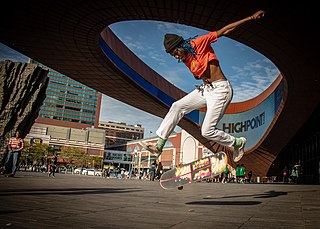
Skateboarding is an action sport that involves riding and performing tricks using a skateboard, as well as a recreational activity, an art form, an entertainment industry job, and a method of transportation. Originating in the United States, skateboarding has been shaped and influenced by many skateboarders throughout the years. A 2009 report found that the skateboarding market is worth an estimated $4.8 billion in annual revenue, with 11.08 million active skateboarders in the world. In 2016, it was announced that skateboarding would be represented at the 2020 Summer Olympics in Tokyo, for both male and female teams.
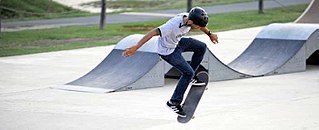
A skateboarding trick, or simply a trick, is a maneuver performed by manipulating a skateboard, usually with one's feet, in a specific way to achieve the desired outcome – the trick.

Ice skates are metal blades attached underfoot and used to propel the bearer across a sheet of ice while ice skating.
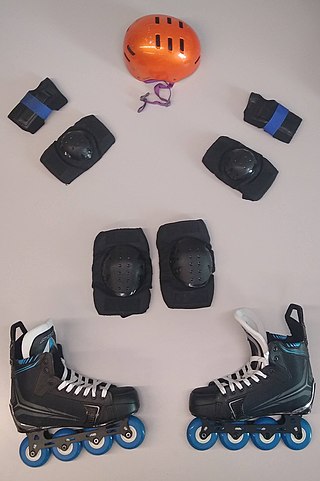
Inline skates are a type of roller skate used for inline skating. Unlike typical roller skates, which have two front and two rear wheels, inline skates typically have two to five wheels arranged in a single line. Some, especially those for recreation, have a rubber "stop" or "brake" block attached to the rear of one or occasionally both of the skates so that the skater can slow down or stop by leaning back on the foot with the brake skate.

Roller skating is the act of travelling on surfaces with roller skates. It is a recreational activity, a sport, and a form of transportation. Roller rinks and skate parks are built for roller skating, though it also takes place on streets, sidewalks, and bike paths.

Inline speed skating is the roller sport of racing on inline skates. The sport may also be called inline racing or speed skating by participants. Although it primarily evolved from racing on traditional roller skates, the sport is similar enough to ice speed skating that many competitors are known to switch between inline and ice speed skating according to the season.
Skating involves any sports or recreational activity which consists of traveling on surfaces or on ice using skates, and may refer to:

Inline skating is a multi-disciplinary sport and can refer to a number of activities practiced using inline skates. Inline skates typically have two to five polyurethane wheels depending on the style of practice, arranged in a single line by a metal or plastic frame on the underside of a boot. The in-line design allows for greater speed and maneuverability than traditional roller skates. Following this basic design principle, inline skates can be modified to varying degrees to accommodate niche disciplines.
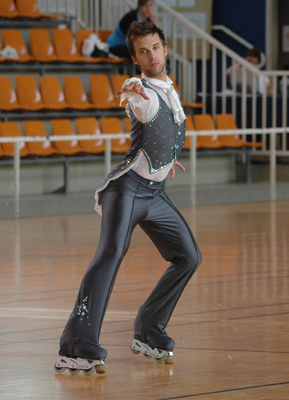
Artistic roller skating is a competitive sport similar to figure skating but where competitors wear roller skates instead of ice skates. Within artistic roller skating, there are several disciplines:

Dirtsurfing is the sport of riding a Dirtsurfer brand inline board. This new Australian boardsport is correctly known as inline boarding because Dirtsurfer is a trademark protected brand name.
Soap was the brand name of shoes made for grinding, similar to aggressive inline skating. They were introduced by Chris Morris of Artemis Innovations Inc. with the brand name "Soap" in 1996. They have a plastic concavity in the sole, which allows the wearer to grind on objects such as pipes, handrails and stone ledges. The company and its product rapidly gained popularity through fan sites, a video game and live demonstrations. Soap fell to legal vulnerabilities and was sold twice, eventually bringing the brand to Heeling Sports Limited.

Zytel is a trademark owned by Celanese and used to make different high-strength, abrasion and impact-resistant thermoplastic polyamide formulations, in the family of material more commonly known as nylon. The Zytel product line is based mostly on nylon 66, but also includes grades based on nylon 6 as a matrix, long chain nylons such as nylon 610, and copolymers including a transparent resin called Zytel 330. Resins based on polyphthalamides are branded 'Zytel HTN'. The Zytel product range takes advantage of the fact that nylons are one of the most compatible polymers with modifiers and so offers grades with varying degrees of fiberglass, from 13% to 60%, rubber toughened resins and flame retarded grades. Nylon resins with mineral reinforcements are branded 'Minlon'.
A freestyle skateboarding trick is a trick performed with a skateboard while freestyle skateboarding. Some of these tricks are done in a stationary position, unlike many other skateboarding tricks. The keys to a good freestyle contest run are variety, difficulty, fluidity, and creativity. This is an incomplete list, which includes most notable tricks.
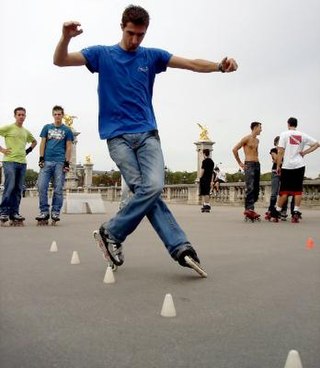
Freestyle slalom skating is a highly technical field of roller skating that involves performing tricks around a straight line of equally spaced cones. The most common spacing used in competitions is 80 centimetres (31 in), with larger competitions also featuring lines spaced at 50 centimetres (20 in) and 120 centimetres (47 in).
A skateboard style refers to the way a skateboarder prefers to ride a skateboard. Skateboard styles can be broadly divided into two different categories: skateboarding to perform tricks and skateboarding as a means of transportation. Styles of skateboarding have evolved and are influenced by a number of factors including sociocultural evolution, mass media, music, technology, corporate influence and individual skill level.

Aggressive inline skating is a sub-discipline of inline skating in the action sports canon. Aggressive inline skates are specially modified to accommodate grinds and jumps. Aggressive skating can take place on found street obstacles or at skate parks.

Street skateboarding is a skateboarding discipline which focuses on flat-ground tricks, grinds, slides and aerials within urban environments, and public spaces. Street skateboarders meet, skate, and hang out in and around urban areas referred to as "spots," which are commonly streets, plazas or industrial areas. To add variety and complexity to street skateboarding, obstacles such as handrails, stairs, walls, flower beds, bins, park benches, picnic tables, and other street furniture may be traversed as single tricks or as part of a series of consecutive tricks called a "line."

Vert skating or vertical skating is a discipline using skates like inline skates or roller skates on a vert ramp, a style of half-pipe. In vert skating, the skater is able to achieve more air-time as compared to other styles of skating, meaning skaters can perform complicated aerial maneuvers and acrobatic tricks, such as spins and flips.














